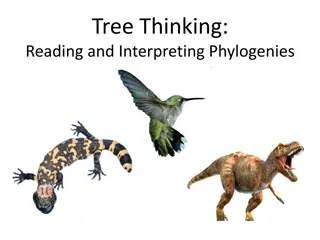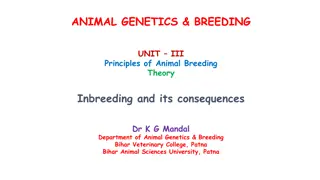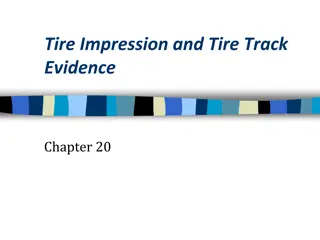Understanding Human Evolution: Evidence of Common Ancestors
Explore evidence supporting the common ancestors for living hominids, including humans. Delve into phylogenetic trees, shared characteristics with African apes, and anatomical differences. Learn about the Hominidae family, genus Homo, and the terms "hominid" and "hominin."
Download Presentation

Please find below an Image/Link to download the presentation.
The content on the website is provided AS IS for your information and personal use only. It may not be sold, licensed, or shared on other websites without obtaining consent from the author. Download presentation by click this link. If you encounter any issues during the download, it is possible that the publisher has removed the file from their server.
E N D
Presentation Transcript
LIFE SCIENCES GRADE 12 CAPS STRUCTURED, CLEAR, PRACTICAL - HELPING TEACHERS UNLOCK THE POWER OF NCS KNOWLEDGE AREA: Diversity, Change and Continuity TOPIC 4.2:Human Evolution Evidence of Common Ancestors for Living Hominids including Humans
SUMMARY OF PRESENTATION Phylogenetic tree to show the family Hominidae Lines of Evidence that Support the Idea of Common Ancestors for Living Hominid, Humans included Characteristics that Humans share with the African Apes Anatomical Differences between the African Apes and Humans
PHYLOGENETIC TREE TO SHOW THE FAMILY HOMINIDAE Before we look at the phylogenetic tree we must first study the classification of humans. Humans are found in the class mammalia. They belong to the order Primates and then They are found in the sub-order Anthropoidea This sub-order is made up of 2 families. These are family Hylobatidae, and family Hominidae. Humans fall into the family Hominidae.
PHYLOGENETIC TREE TO SHOW THE FAMILY HOMINIDAE Then genus Homo Finally species Homo sapiens This is all shown in the picture alongside. Here we often come across the terms hominid and hominin. Lets look at these 2 terms. Classification of Humans
PHYLOGENETIC TREE TO SHOW THE FAMILY HOMINIDAE Hominid refers to the group which contains modern humans, chimpanzees, gorillas and orangutans. It also includes all their immediate ancestors. In other words all the organisms found in the family Hominidae. Hominin refers to modern humans and all the extinct human species. It also includes all our immediate ancestors. Now will look at how the humans are similar and different to the African apes.
PHYLOGENETIC TREE TO SHOW THE FAMILY HOMINIDAE The African apes include the gorillas, chimpanzee and bonobos. Now lets look at the phylogenetic tree. Chimpanzee Bonobos
TERMINOLOGY: TERM: Hominid DEFINITION: USE IN SENTENCE: Hominid refers to the group which includes modern humans, chimpanzees, gorillas and orangutans. Humans belong to the family Hominidae
TERMINOLOGY TERM: Hominin DEFINITION: USE IN SENTENCE: Hominin refers to modern humans and all the extinct human species Australopithecus and Paranthropus belong to the group Hominin
PHYLOGENETIC TREE TO SHOW THE FAMILY HOMINIDAE The phylogenetic trees on the next 2 slides gives some information on human evolution. We will use both these trees to trace human evolution from about 6 million years ago.
PHYLOGENETIC TREE TO SHOW THE FAMILY HOMINIDAE
PHYLOGENETIC TREE TO SHOW THE FAMILY HOMINIDAE
PHYLOGENETIC TREE TO SHOW THE FAMILY HOMINIDAE Between 6 to 7 mya the first bipedal primates appeared. These organisms had the following features: Small brain size Foramen magnum had a forward position. Small canine teeth Then about 4mya Australopithecus appeared. They had features of both primitive apes and modern humans. They had the head of primitive apes and from the neck down they looked like the modern humans. Therefore they are often called ape-men. a. b. c.
PHYLOGENETIC TREE TO SHOW THE FAMILY HOMINIDAE The features shared with primitive apes were 1. Protruding jaws 2. Heavy brow ridges 3. Slopping faces 4. Small brain. Australopithecus
PHYLOGENETIC TREE TO SHOW THE FAMILY HOMINIDAE A new genus appeared between 4.32 and 4.51 million years ago. This was the Ardipithecus. This genus was made up of 2 species. They were A. ramidus and A. kadabba A. kadabba lived about 5.6 mya. A. ramidus
PHYLOGENETIC TREE TO SHOW THE FAMILY HOMINIDAE A. ramidus had the following features A small brain A pointed face and poorly developed chin A grasping big toe for swinging from branch to branch of trees. It was also adapted for bipedalism. Then about 2 mya the australopithecines gave rise to Homo habilis (the handy man) H. habilis was referred to as the handy man because fossil evidence showed that they used tools. H. habilis was first of the early humans. H. habilis was different from the australopithecines in the following way 1. 2. 3. 4.
PHYLOGENETIC TREE TO SHOW THE FAMILY HOMINIDAE 1. Less pronounced brow ridges 2. More human like teeth 3. A flatter face 4. A more rounded head 5. A brain capacity of 600 to 750ml. homo habilis
PHYLOGENETIC TREE TO SHOW THE FAMILY HOMINIDAE It is thought that about 1.5 mya H. habilis gave rise to Homo erectus. H. erectus had the head of an ape but from the neck down it looked like modern man. It was as tall as modern man and had a larger brain size of 700 ml to 1300ml. Homo erectus
PHYLOGENETIC TREE TO SHOW THE FAMILY HOMINIDAE Then about 150 000 to 200 000 years ago h. erectus gave rise to Homo sapiens. We will look at these in a little more detail later on.
LINES OF EVIDENCE THAT SUPPORT THE IDEA OF COMMON ANCESTORS FOR LIVING HOMINID, HUMANS INCLUDED Two groups of the African apes share a common ancestor with humans. These 2 groups of apes are the chimpanzee and bonobos. We want to look at evidence that support the idea of a common ancestor. We look at 3 lines of evidence. These are Fossil evidence Genetic evidence Cultural evidence Lets look at each of these in some detail.
LINES OF EVIDENCE THAT SUPPORT THE IDEA OF COMMON ANCESTORS FOR LIVING HOMINID, HUMANS INCLUDED Fossil Evidence: From our earlier discussion we can see that many hominin fossils have been discovered over the years. Hominin fossils belong to at least 20 species. These fossil provide evidence for a close evolutionary relationshipbetween humans and the great apes. The fossils use anatomy to show this relationship. The fossils provide 2 lines of evidence. 1.
LINES OF EVIDENCE THAT SUPPORT THE IDEA OF COMMON ANCESTORS FOR LIVING HOMINID, HUMANS INCLUDED These are Transitional fossils: This refers to the immediate fossils between a group and their ancestor. In this case the transitional fossils have characteristics of both the apes and humans. The great ape characteristics are also found in the common ancestor, but The human characteristics occur only in the hominins. a)
THE IDEA OF COMMON ANCESTORS FOR LIVING HOMINID, HUMANS INCLUDED The Oldest fossils: These fossils have more characteristics of the great apes than the younger fossils. These younger fossils are more like the modern human. Over a period of time we see that the fossils become more human like than ape like. b) We shall look at the similarities and differences between the great apes and humans a little later.
LINES OF EVIDENCE THAT SUPPORT THE IDEA OF COMMON ANCESTORS FOR LIVING HOMINID, HUMANS INCLUDED Genetic Evidence: The DNA base pairing of humans and the Great apes are almost identical. The human DNA sequence is most similar to the chimpanzee. 2. Humans and chimpanzee have 98.76% of the base pair sequence in common. Since DNA sequence is so similar it provides evidence for a close relationship between humans and chimpanzees.
LINES OF EVIDENCE THAT SUPPORT THE IDEA OF COMMON ANCESTORS FOR LIVING HOMINID, HUMANS INCLUDED Cultural Evidence: Fragments of sticks, burned bones, stone weapons and tools etc, were used as cultural evidence for human evolution. Chimpanzees also use tools , for example using stones to open nuts. Young chimpanzee learn behaviour from watching their mothers. Therefore it is believed that the common ancestor of humans and chimpanzee also used similar tools in a similar way. 3.
TERMINOLOGY: TERM: Transitional fossils DEFINITION: USE IN SENTENCE: refers to the immediate fossils between a group and their ancestor Transitional fossils are used can be used as fossil evidence to show relationship between a group and their ancestor.
CHARACTERISTICS THAT HUMANS SHARE WITH THE AFRICAN APES Many of the early mammals lived on trees. Many of the African apes are still adapted for an arboreal life. Humans share the following characteristics with the African apes and other primates The upper limbs The brain Vision Number of Offspring Upright posture 1. 2. 3. 4. 5.
CHARACTERISTICS THAT HUMANS SHARE WITH THE AFRICAN APES The Upper Limbs: 1. Primates have very long arms, which they move freely. They are able to move their arms freely because The socket is very shallow. The scapula is not attached to the vertebral column. They do not have claws, instead they have flat nails. Their fingertips are bare and contain a large amount of nerve endings. Finally all primates have opposable thumbs. 1. 2.
CHARACTERISTICS THAT HUMANS SHARE WITH THE AFRICAN APES The long arms are used to gather fruit from the tips of tree branches. Their bare fingertips are very sensitive, this makes precision work possible. Therefore they are able to make and use tools. The opposable thumbs makes the power grip and precision grip possible. Like primates humans have opposable thumbs, flat nails instead of claws and freely moving upper limbs.
CHARACTERISTICS THAT HUMANS SHARE WITH THE AFRICAN APES Brain: We find that when we compare the brain to body size, the primates have large brains compared to their body size. This enables them to process large amounts of information. Parts of the brain responsible for interpretation information coming from the hands and eyes are enlarged. The olfactory organ is much reduced because primates do not depend on the sense of smell. 2.
CHARACTERISTICS THAT HUMANS SHARE WITH THE AFRICAN APES Vision: 3. Their eyes are found in the front. They display both stereoscopic and binocular vision. They have rods and cones to enable a more clear and colour vision.
CHARACTERISTICS THAT HUMANS SHARE WITH THE AFRICAN APES Number of Offspring Produced: Primates produce far less offspring. Parental care is intensive. 4. Upright Posture: They have an upright posture, which allows for the primates to walk on two legs. This allows for better view of the surroundings. Upper limbs are free for carrying things such as food, babies and tools. 5.
TERMINOLOGY: TERM: Arboreal DEFINTION: USE IN SENTENCE: Refers to living in trees Chimpanzees have an arboreal life
TERMINOLOGY: TERM: Stereoscopic vision DEFINITION: USE IN SENTENCES Refers to see the depth and solidity of objects Primates exhibit stereoscopic vision
TERMINOLOGY: TERM: Binocular vision DEFINITION: USE IN SENTENCE: The process of looking at an object with both eyes Humans have binocular vision
SOMETHING FOR YOU TO DO: List the characteristics that humans share with the African apes.
SOLUTION: Large brains compared to their body mass. Therefore a large skull. Reduced sense of smell due to a reduced olfactory center in the brain Parts of the brain that process information from hands and eyes are larger. Retina contains cones to make color vision possible. Stereoscopic vision Binocular vision Long upper arms Upper arms full and free movement 1. 2. 3. 4. 5. 6. 7. 8.
SOLUTION: Forearm can rotate because of elbow joint 9. 10. No claws, nails are flat 11. No hair on fingertips-bare fingertips 12. Opposable thumbs 13. Upright posture. This is a good learning tool use it to learn the similarities.
TERMINOLOGY: TERM: Opposable thumb DEFINITION: USE IN SENTENCE: The thumb is opposite the fingers The opposable thumb allows for the precision grip.
ANATOMICAL DIFFERENCES BETWEEN THE AFRICAN APES AND HUMANS Anatomy refers to structural make up of an organism. In this section we will look at how the humans and African apes are structurally different from each other. The following anatomical differences occur between the humans and the African Apes Bipedalism Brain size Dentition Flat face/Prognathism Cranial ridges Brow ridges 1. 2. 3. 4. 5. 6.
ANATOMICAL DIFFERENCES BETWEEN THE AFRICAN APES AND HUMANS There is fossil evidence to support these anatomical differences. Now lets look at each of these in some detail Bipedalism: 1. The African apes sit upright and are able to walk on 2 feet. However they do this only sometimes, while humans walk on 2 legs all the time. Animals that show bipedalism have a different arrangement of the vertebral column to the head
ANATOMICAL DIFFERENCES BETWEEN THE AFRICAN APES AND HUMANS Therefore the position of the foramen magnum had to change. It moved from the back of the skull to a forward position at the bottom of the skull as shown alongside. This means that in animals that show bipedalism, the foramen magnum is in a forward position at the bottom of the skull, while Position of Foramen Magnum
ANATOMICAL DIFFERENCES BETWEEN THE AFRICAN APES AND HUMANS The animals that show quadrupedalism have a foramen magnum at the back of the skull.
ANATOMICAL DIFFERENCES BETWEEN THE AFRICAN APES AND HUMANS In addition animals with bipedalism had a much wider and shorter pelvis, because the pelvic girdle had to support the weight of the body. While quadrupeds have long, narrow pelvic girdles. Comparison of pelvic girdle of human and chimpanzee
ANATOMICAL DIFFERENCES BETWEEN THE AFRICAN APES AND HUMANS Finally the spine of an organism with bipedalism is straighter than a quadrupedal. Comparison of the Spine
TERMINOLOGY: TERM: Bipedalism DEFINITION: USE IN SENTENCE: Refers to a type of locomotion where the animal moves on 2 hind legs in an upright position The African apes move in a bipedal fashion only sometimes.
ANATOMICAL DIFFERENCES BETWEEN THE AFRICAN APES AND HUMANS Brain Size: Over the time the brain size of the hominin species has gradually increased. Homo sapiens have a brain size twice that of Homo habilis. The brain size of the first bipedal apes was half the size of the brain of Homo habilis. The brain of the modern man is the biggest. It ranges in size from 1200ml to 1800ml. 2.
ANATOMICAL DIFFERENCES BETWEEN THE AFRICAN APES AND HUMANS The advantage of the large brain size compared to their body masses over those apes that had a smaller brain compared to their body mass size is greater intelligence. But it must be noted that this does not apply to modern humans. Since humans have a larger brain they also have a larger skull. Dentition: Apes have large canines that protrude. In humans the canines are much smaller and is shaped almost like an incisor. 3.
ANATOMICAL DIFFERENCES BETWEEN THE AFRICAN APES AND HUMANS The incisors in humans do not stick out, while in chimpanzees they stick out spatulas or spoons. The dental formula a of humans is 2.1.2.3 The dental formula of the oldest primates are 2.1.3.3 2.1.3.3 The apes have a u-shaped jaw with parallel sides and the front is slightly rounded. The incisors are found at the front and canines, premolars and molars are on the side. Humans have a gently curved jaw. 2.1.2.3
TERMINOLOGY: TERM: Dentition DEFINITION: USE IN SENTENCE: Refers to the development of teeth and the way they are arranged in the mouth The oldest primates and humans have different dentition.
ANATOMICAL DIFFERENCES BETWEEN THE AFRICAN APES AND HUMANS A flat face / Prognathism: Modern humans have a flat face. The following features ensures that humans have a flat face The foreheads of modern humans do not slope backwards while the forehead of the ape men slope backwards. Humans have a well developed chin on their lower jaws. Human chins are square shaped, this is thought to be an adaptation for speech. Chimpanzees have rounded chins. 4. 1. 2.

















































